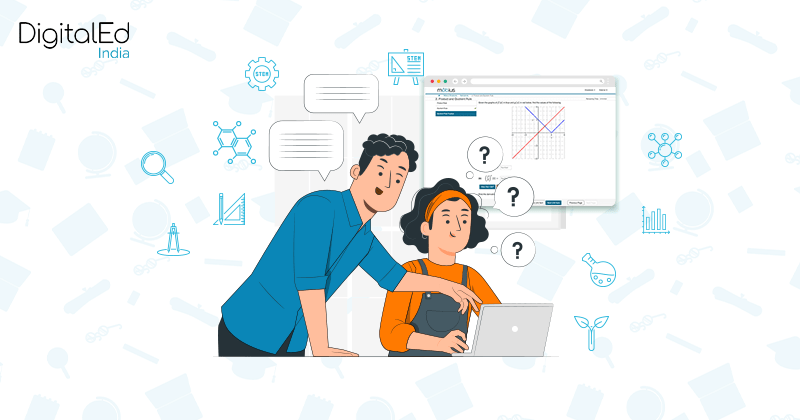Digital Content Creation Guide for Deploying STEM Courses
Digital content creation for STEM education is gaining a lot of momentum due to the surging demand for online teaching platforms.
The global pandemic closed down schools and triggered a watershed moment for the education industry, multiplying the dependency on technology and digital content creation. The text-heavy learning environment of the past is giving way to audio and video-rich learning experiences, contributing directly to the efficiency and success of online learning platforms.

Even with a dichotomy of experiences and opinions, the education industry has acknowledged and accepted the significance of technology and digital teaching methods.
Unlike many other subjects, the digital content creation process for STEM courses can be tricky without proper guidance or knowledge. STEM encompasses the 4 fundamental subjects– Science, Technology, Engineering, and Mathematics, which requires educators to consider many factors before incorporating such complicated concepts into the process of digital content creation.
So, without further ado, let’s begin.
What factors to consider while creating digital content for STEM courses?
These are the top considerations that educators should keep in mind during digital content creation for STEM-related courses.
• Content must follow scientific principles and be educational in order to teach new concepts;
• Content should include real-world tasks with a focus on solving problems;
• Content that promotes an inventive approach and original thinking;
• The content must be up-to-date and pertinent to current events and technological advancements;
• Multimedia content should be included along with interactive elements to keep the students engaged and interested;
• With feedback and self-evaluation, there should be room for ongoing development and improvements;
• Group projects can also be included as leadership, teamwork, and other communication skills are important for STEM students.
Apart from considerations, educators should also understand the main areas to focus on while creating content for courses related to STEM.
What are the main areas to focus on while creating digital content for STEM courses?
The following areas are a significant part of the digital content creation and deployment:
- Critical Thinking: STEM courses must incorporate projects, tasks, or lessons that develop critical thinking skills, allowing students to solve complex problems in today’s world through analysis, interpretation, explanation, and evaluation.
- Digital Literacy: Digital content for STEM education must create an environment of digital literacy, teaching the students to access, evaluate, utilize and manage information for various purposes.
- Interactivity: In an ideal scenario, online STEM courses should be interactive in nature, allowing the students to stay connected with the instructors and receive feedback whenever needed.
- Self-Evaluation: Provide digital content that promotes self-evaluation, allowing the students to be more self-aware and reflective of their own progress to boost confidence and knowledge retention.
Last but not least, thoroughly understanding the different methods to teach STEM subjects facilitates the successful deployment of e-learning content.
What are the different teaching methods for STEM courses?
Project-Oriented Learning:
This approach presents real-world challenges and relevant information to solve the given problems. This strategy tries to enhance and expand the thinking capacity of STEM students through research and originality.
Digital content creation for STEM courses must include projects or tasks that can be applied to real-world situations.
Problem-Oriented Learning:
Introducing a problem-solving strategy at an early stage helps the students in identifying gaps in knowledge, implementing creative solutions, and grasping complex concepts with ease.
Students develop outside-the-box thinking by solving complex problems.
Research-Oriented Learning:
This approach promotes the student’s natural curiosity and scientific way of thinking. It is a technique that allows a student to explore difficult concepts and then pose the appropriate questions.
Deploy digital content that promotes research and analysis, allowing the students to delve deeper into the concept.
Möbius is an online learning platform that facilitates effective digital content creation and deployment for STEM classes. Let’s explore this further.
How can the Möbius Platform help in successfully deploying STEM courses?
The interactive Möbius platform promotes a revolutionary blended learning approach that allows teachers and students to stay connected throughout the entire learning process. It bridges the knowledge gaps, builds learning continuity, and maximizes information retention in an engagingly interactive learning environment.
• Instead of sharing PDFs, deliver digital content for STEM courses on a highly interactive and seamless online learning platform.
• Enhance digital content creation and deployment with a huge selection of pre-built question types that can be added in-between STEM lessons.
• Help the students better visualize intangible concepts with multimedia content like images, graphs, videos, etc.
• Simplify and hasten the time-consuming assessment process with automated grading.
• Allow the students to self-evaluate repeatedly through automated randomized questions.
• Analyze progress, identify individual learning gaps, and provide feedback rapidly.
• Interact with the students and stay involved in the “outside the class” learning experience at all times
DigitalEd is on a mission to enhance and simplify digital content creation and deployment for STEM courses, facilitating a comprehensive learning and teaching environment that benefits everyone.
The Möbius Platform – Interactive STEM Learning Ecosystem for the Innovators of Tomorrow.
Contact us to learn more.